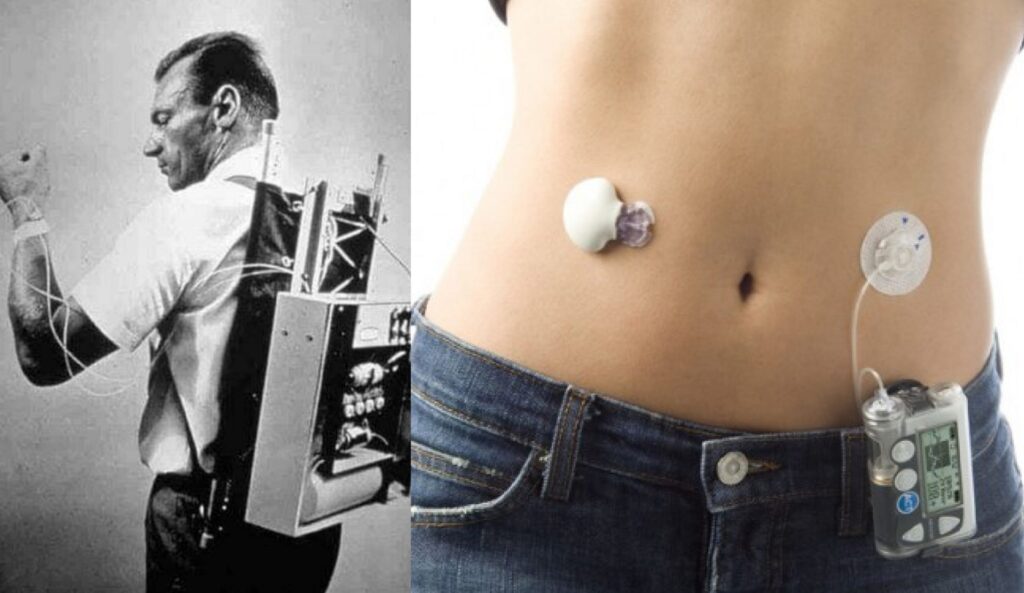Insulin Delivery Device Evolution
The landscape of diabetes management has witnessed a revolutionary wave of advancements in insulin delivery methods. From the initial era of injections to the emergence of insulin pens, and subsequently, insulin pumps, the trajectory has been marked by a pursuit of better glucose control and enhanced patient experience.
These strides in insulin delivery technology brought incremental improvements, but gaps persisted, especially in maintaining consistent blood glucose levels.
However, the introduction of Continuous Glucose Monitoring (CGM) devices transformed the landscape by providing real-time data, and the integration of CGM with insulin pumps birthed the Artificial Pancreas Systems (APS), setting new benchmarks in diabetes care. Please fill out the form if you or a friend would like more information on CGM devices.
The saga of insulin delivery evolution provides crucial insights into the critical role of medical devices in reshaping the diabetes management landscape.
Read Guide about Wegovy Dosage Guide: The Best Way For Weight Loss
Unveiling the Journey: The Evolution of Insulin Delivery
Traditional insulin delivery methods, including syringes, insulin pens, and initial insulin pumps, have undergone progressive evolution. While syringes were the earliest form of insulin administration, the advent of insulin pens offered greater accessibility and comfort for self-injection.
Despite these advancements, the challenge of maintaining consistent blood glucose control persisted. Early insulin pumps, though introduced continuous subcutaneous insulin infusion, were bulky and necessitated frequent site changes. Patients grappled with discreetness, societal perceptions, and intricate calculations, leading to hurdles in managing diabetes effectively.
Must Read CGMs in noncritical care hospitals optimizes glycemic control
Bionic Technology: Transforming Insulin Delivery
Bionic technology, a fusion of biological and artificial components, has emerged as a game-changer in medical advancements. In the realm of insulin delivery, bionic innovations have reshaped the paradigm by mimicking or enhancing natural bodily functions, notably seen in the development of APS.
These systems utilize cutting-edge algorithms, sensors, and automated insulin pumps to mirror the natural pancreas function. The result? A continuous and automated insulin delivery mechanism that significantly minimizes the need for manual intervention, thereby amplifying glucose control.
The advent of bionic insulin delivery devices stands as a testament to their precision, adaptability, and user-centric design, revolutionizing diabetes management.
Next-Gen Insulin Pumps and Artificial Pancreas Systems
Modern insulin pumps have undergone a metamorphosis, boasting enhanced accuracy, adaptability, and user accessibility. These pumps integrate advanced features like CGM integration, predictive low glucose suspend (PLGS) capabilities, and seamless smartphone connectivity. This integration facilitates real-time adjustments based on CGM data, mitigating hypoglycemic and hyperglycemic risks.
The concept of the artificial pancreas represents a groundbreaking leap in diabetes care. Functioning as an automated insulin delivery system, this closed-loop setup combines CGM and insulin pumps with sophisticated algorithms.
Continuously monitoring glucose levels and administering precise insulin doses, the artificial pancreas aims to replicate the body’s natural insulin response.
The Pinnacle of Patient Benefits
Bionic devices, including advanced insulin pumps and artificial pancreas systems, offer patients a trifecta of convenience, efficiency, and safety in managing diabetes. By automating insulin delivery and fine-tuning insulin profiles, these devices transcend conventional methods, ensuring precise glucose control.
Continuous glucose monitoring and instant responses to glucose fluctuations further fortify patient safety, reducing the incidence of hypoglycemia. This safeguarding of stable blood sugar levels not only enhances overall health but also uplifts the quality of life for individuals navigating diabetes.
Navigating Challenges and Considerations
Despite their transformative potential, advanced diabetes management devices face hurdles, primarily concerning affordability and device maintenance. Ensuring universal access to these technologies and addressing technical glitches while streamlining patient education remains pivotal.
Long-term implications, including device durability, performance, and potential risks like infections, remain under meticulous scrutiny. Rigorous research aims to overcome limitations, ensuring the safety and efficacy of these avant-garde systems for optimal diabetes management and patient welfare.
Also, read about The Commemoration of World Diabetes Day by Leading Medtech Companies
Paving the Path Ahead
The realm of bionic advancements in diabetes care foretells a promising narrative of precise, automated insulin delivery, alleviating the burdens borne by patients while amplifying glycemic control. These innovations signal a beacon of hope for diabetes management, promising a brighter future.
Further research and innovation are indispensable to refine and democratize these technologies, making them accessible to a broader spectrum of patients. Embracing emerging technologies and supporting their evolution will play a pivotal role in augmenting the lives of individuals grappling with this chronic condition.
Continual strides and exploration in the domain of medical devices for diabetes hold the key to a transformed landscape, ensuring improved quality of life for those navigating diabetes. The journey toward enhanced diabetes management remains an ongoing saga, underlining the importance of embracing innovation and progress.


